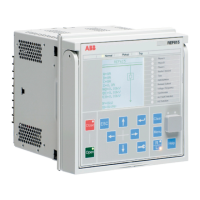15. Self-supervision
The relay’s built-in self-supervision system continu-
ously monitors the state of the relay hardware and
the operation of the relay software. Any fault or
malfunction detected is used for alerting the oper-
ator. A permanent relay fault blocks the protection
functions to prevent incorrect operation.
16. Fuse failure supervision
Depending on the chosen standard configuration,
the relay includes fuse failure supervision function-
ality. The fuse failure supervision detects failures
between the voltage measurement circuit and the
relay. The failures are detected either by the nega-
tive sequence-based algorithm or by the delta volt-
age and delta current algorithm. Upon the detec-
tion of a failure, the fuse failure supervision
function activates an alarm and blocks voltage-de-
pendent protection functions from unintended
operation.
17. Current circuit supervision
Depending on the chosen standard configuration,
the relay includes current circuit supervision. Cur-
rent circuit supervision is used for detecting faults
in the current transformer secondary circuits. On
detecting of a fault the current circuit supervision
function activates an alarm LED and blocks certain
protection functions to avoid unintended opera-
tion. The current circuit supervision function calcu-
lates the sum of the phase currents from the pro-
tection cores and compares the sum with the
measured single reference current from a core bal-
ance current transformer or from separate cores in
the phase current transformers.
18. Access control
To protect the relay from unauthorized access and
to maintain information integrity, the relay is pro-
vided with a four-level, rolebased authentication
system with administrator-programmable individ-
ual passwords for the viewer, operator, engineer
and administrator levels. The access control applies
to the local HMI, the Web HMI and PCM600.
19. Inputs and outputs
Depending on the standard configuration selected,
the relay is equipped with three phase-current in-
puts and one residualcurrent input for non-direc-
tional earth-fault protection, or three phase-cur-
rent inputs, one residual-current input and one
residual voltage input for directional earth-fault
protection or three phase-current inputs, one re-
sidual-current input, three phase-voltage inputs
and one residual voltage input for directional
earth-fault protection and directional overcurrent
protection. Standard configuration L includes one
three sensor inputs for the direct connection of
three combi-sensors with RJ-45 connectors. As an
alternative to combi-sensors, separate current and
voltage sensors can be utilized using adapters. Fur-
thermore, the adapters also enable the use of sen-
sors with Twin-BNC connectors.
-
tional residual-current inputs are available, that is,
in applications requiring sensitive earth-fault pro-
tection and featuring core-balance current trans-
formers. The three phase-voltage inputs and the
residual-voltage input covers the rated voltages
60...210 V. Both phase-to-phase voltages and
phase-to-earth voltages can be connected.
The phase-current input 1 A or 5 A, the residual-cur-
rent input 1 A or 5 A, alternatively 0.2 A or 1 A, and
the rated voltage of the residual voltage input are
selected in the relay software. In addition, the bi-
nary input thresholds 16…176 V DC are selected by
adjusting the relay’s parameter settings.
All binary inputs and outputs contacts are freely
configurable with the signal matrix or application
configuration functionality of PCM600.
-
nal diagrams for more information about the in-
puts and outputs.
Optionally, a binary input and output module can
be selected. It has three high speed binary outputs
(HSO) and it decreases the total operate time with
typically 4...6 ms compared to the normal power
outputs.
28 REF615 ANSI 5.0 FP1 FEEDER PROTECTION AND CONTROL

